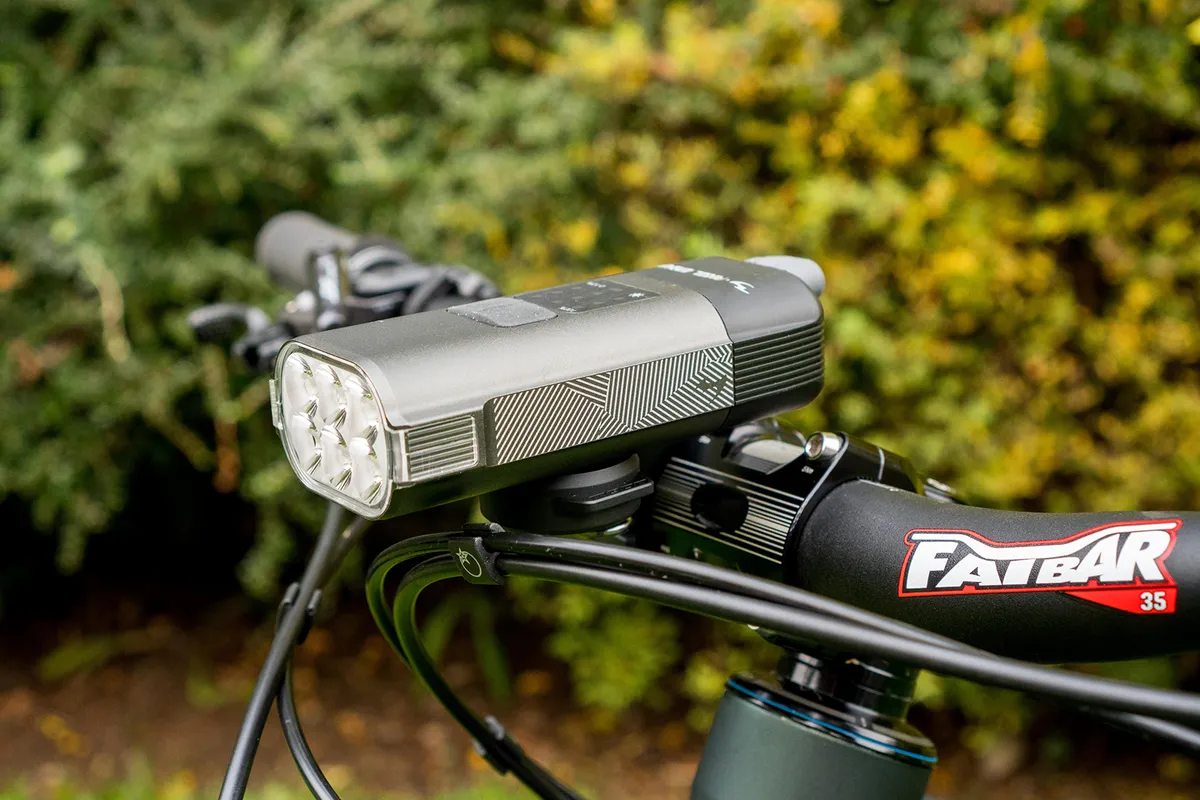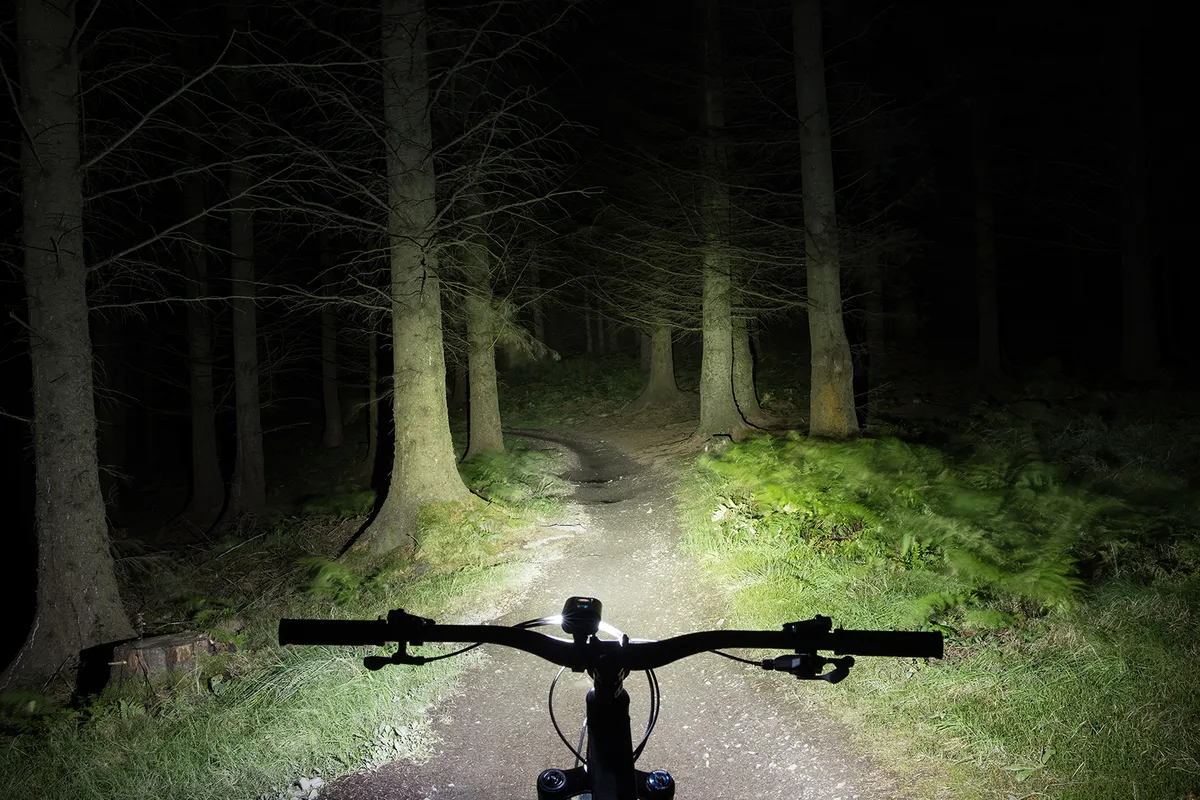The Moon Rigel Enduro – a new model in Moon’s range – packs a mighty 2,600 lumens at max power that's emitted from six forward-facing LEDs.
The all-in-one unit sports a 9,000mAh battery, two buttons and an LED matrix display for mode and battery information.
Plus it has a bar-mounted wired remote.
Moon Rigel Enduro specifications and details
The out-front style mount uses a Garmin-style twist-lock design with a sprung locking pin to hold the light securely.
Rubber shims are included to size it to different bar diameters, and it attaches to the bar with a 2.5mm Allen bolt.
The head unit’s CNC’d aluminium body is IPX7 waterproof rated and has two buttons – that mirror the remote’s functions – where one cycles between the eight lighting modes and the other lifts it into Boost mode for the full 2,600 lumens.
Each mode illuminates a corresponding number and shape of LEDs on the matrix display. There is a built-in ambient light sensor too.
This activates an Intelligent Brightness Function (IBF) programme where the light changes to its standby mode in the day and reverts to any one of its user-selected modes once the darkness threshold is reached.

A further Variable Lumen System (VLS) mode – where the light’s output can be defined on a dimming and brightening scale – is also accessible.
The unit’s USB-C port doubles up as its charging and remote plug, and the two-button remote fastens to the bar with a Velcro strap and has a 33cm long cable.
Four of the light’s six LEDs have a narrow-angle – spotlight – lens, while the two outermost bulbs on the lower row have a wide-angle lens, designed to flood light across the trail.
Moon Rigel Enduro performance
Although the two Allen bolts that attach the clamp to the bar are only 2.5mm, the clamp is very secure. Its out-front style also looks sleek, with the main bulk of the unit sitting next to and slightly in front of the stem.
The rubber shims for fine-tuning the bar fit don’t have any grooves, so tend to splay outwards as the clamp is tightened and look untidy, although this doesn’t affect clamp performance and the light proved to be very stable over rough terrain.
The remote’s Velcro strap also attached it securely, meaning I could easily change modes on the move, although I spent most of my time in mode 1 (2,100 lumens) or Boost (2,600 lumens).
The remote/light USB-C connection interface is stiff and I struggled to get the two to connect reliably without using excessive force. Once connected, I had no issues, though.
In my tests, the Rigel lasted for 2hrs 3mins on full power, just beating Moon’s claimed run time.

Unfortunately, the Rigel Enduro isn’t intuitive to operate. I wasn’t able to just start using the light, and couldn’t access the Boost function without studying the instruction manual first.
The twin button setup doesn’t work logically and the matrix display isn’t easy to decipher when shifting between modes and using the VLS or IBF. It does display the remaining battery charge clearly, though.
These difficulties aside, the Rigel has plenty of power out on the trail, making it easy to spot roots, rocks and other obstacles.
It certainly packs a fair punch, with its 2,100-lumen mode being ample for most scenarios. Boost it to 2,600 lumens and it feels like it has a higher output than claimed.
Arguably, there’s enough power on tap to ride most trails you’d encounter, with only enduro-style riding requiring more illumination.
The LEDs have a white and blue hue that is quite harsh and creates some contrast and dazzle on the trail, but is most noticeable when compared back-to-back with a yellow or green-hued light.
The Rigel has a wide beam spread with a long throw, which is great for fireroad blasting and high-speed, technical trails that aren’t too winding.
The forward projection is far enough away to not have a noticeable cut-off point, while peripheral illumination has a gradual fade, rather than a defined line between light and dark.
On tight and twisty trails, where the outer beam isn’t bright enough for truly committed turns and line choices, the light’s limits are noticeable. You can vaguely spot a line but more side-to-side power would be better.
However, there is plenty of downward light projection, so landings don’t go dark when the front wheel is in the air.
Moon Rigel Enduro bottom line
With plenty of power and a decent beam pattern, the Rigel will work as a bar-mounted standalone light. If paired with a helmet light, you could tackle most enduro-style riding with confidence.
It’s a shame it’s unintuitive to use and the matrix display is hard to decipher at times, but for the price, it’s pretty good.
How we tested
For our 2021 MTB lights test, we put eight units to the test, starting at just over £100 and rising all the way to nearly £500.
Whatever your budget, there should be one that will suit your needs.
Of course, there are plenty of lights available online for less money, but they won't necessarily offer the same reliability or aftersales support as the trusted brands tested here.
All the lights chosen have a minimum output of a claimed 1,500 lumens, but some are much brighter. Generally, more lumens equates to a higher price.
As well as testing how each light performs on the same trail on back-to-back runs – assessing beam pattern, LED colour, ease of operation and, most importantly, light projection – we also timed them all on max power to find out just how long the batteries last, and whether they live up to the brand’s claims.
You can find all of our top-rated options in BikeRadar's guide to the best mountain bike lights.
Also tested
Product
| Brand | Moon |
| Price | A$342.00, £190.00, $261.00 |
| Weight | 378g |
Features
| Light type | front |
| Remote switch | yes |
| Integrated battery | yes |
| Features | Run time: 2hrs 3mins (measured) |
| Output (lumens) | 2600 |
